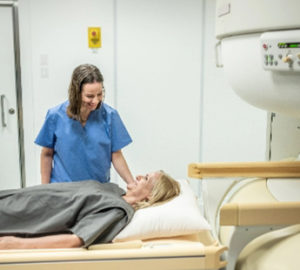
A typical test could take 40 minutes; a “fast MRI” can be done in as little as 10.
(Katie Couric Media – Rachel Uda) — Getting an MRI is not exactly a comfortable experience. You’re stuck in a big metal tube and instructed to remain perfectly still while what sounds like a car alarm triggered at arm’s length reverberates around you. But it can be a lifesaving test, especially for the millions of women who have dense breasts. MRIs — scans that use magnetic fields and radio waves to image soft tissue in places ranging from the brain’s white matter to the ligaments in your knees — are an important tool to detect tumors. And they’re particularly good at picking up on breast cancer that other screening methods like mammograms might miss. Unfortunately, they’re pricey and, for the claustrophobic, they can be somewhat of a harrowing process.
Fortunately, a cheaper and much quicker method has been developed. Here’s everything you need to know about the aptly named abbreviated MRI, or fast MRI, and whether it could be a good option for you.
What is a fast MRI?
The fast MRI process is fairly similar to the typical breast MRI: You’re given contrast (a special dye that appears on the scan) through an IV, and you still have to lay in the tube and endure that ear-splitting noise. But instead of lasting 40 minutes, the abbreviated MRI can be done in as little as 10.
The conventional procedure takes up to 16 sets of images, but this new technique usually relies on just three. The screening provides less detail of the chest wall and the “kinetics” of a particular area — or how it moves over time — but in studies, it’s proven to be still highly effective at spotting cancer, says Wendie Berg, M.D., Ph.D., a leading radiology researcher at the University of Pittsburgh Medical Center.
“You lose a little bit of information, but not much,” she tells us.
And because it can be done so quickly, clinicians hope it’ll entice more high-risk women, who may have avoided MRIs out of fear, to get screened. In a study Dr. Berg helped run in 2009, she found that about a quarter of women with an elevated risk of breast cancer refused a free full-length MRI because of claustrophobia.
For now, fast MRIs typically refer to these breast screenings. But researchers are also trying to speed up other types of MRIs, like those mapping the liver or brain, chiefly through artificial intelligence. Clinicians have found that with A.I. software, fewer pictures are needed to develop highly detailed scans of the valves of the heart, for example, which cuts down on how long the test takes.
Who should consider a fast MRI?
Fast MRI is a valuable additional screening tool for women with dense breasts, who are at average risk. (Women known to be high risk because they carry a genetic mutation, have a strong family history, or have had chest radiation should have a full MRI, says Carrie Rochman, M.D., an associate professor at the University of Virginia School of Medicine.) About 40 percent of women are thought to have dense breasts, which makes them harder to screen. Their breasts have high levels of fibrous and glandular tissue, which on mammograms appear white — similar to tumors.
If you fall into this category, your doctor may recommend a digital breast tomosynthesis (also called DBT or 3-D mammography), which is more effective but still not quite as good as an abbreviated MRI, Dr. Berg says. According to a 2016 study that compared the two techniques in 1,444 women, fast MRI caught tumors in 17 cases, while DBT only detected seven.
In the past few years, the tool has slowly become more popular, but it’s still not widely used because it’s often not covered by insurance. (Some states require insurance providers to cover MRIs for certain women at higher risk. In those cases, coverage “generally” extends to fast MRIs, if it’s billed in a specific way — using what’s called a modifier 52 — that indicates it’s a partial or reduced procedure, Dr. Berg says.)
The self-pay model, where women pay for the exam entirely on their own, is also fairly common and is used in more than 200 facilities. According to Dr. Berg, the cost can vary from $250 to $850.
But a new bill could make the test much more affordable. Under the Find It Early Act, a bill that Katie helped introduce this year in Congress, insurance providers would be required to cover screening and diagnostic breast imaging at no out-of-pocket cost for high-risk women and those with dense breasts. The law would cover mammograms, ultrasounds, MRIs, and fast MRIs.
The technique is just another tool in our arsenal to catch breast cancer earlier in more women — and ultimately save lives.
